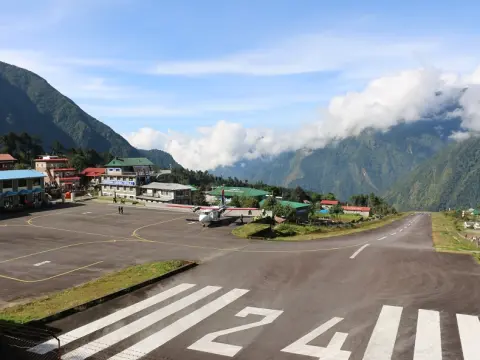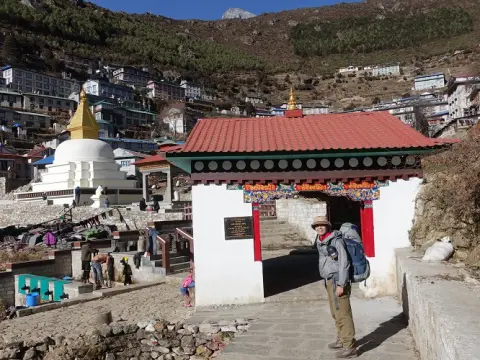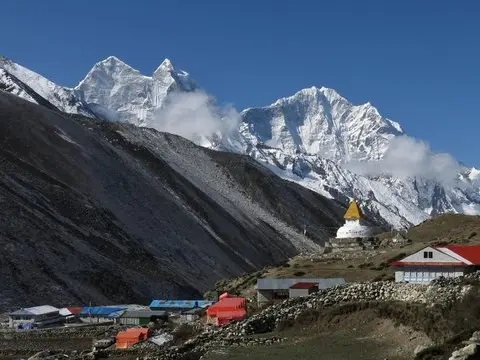Introduction
To begin with, Gorakshep is a small village at an altitude of 5,164 meters. It is the last destination before Everest Base Camp (5,364 meters). Gorakshep is used by many trekkers to rest and acclimatize before the final hike. The village offers basic facilities like lodges and tea houses despite its remote location.Also, Gorakshep falls within Sagarmatha National Park, a UNESCO World Heritage site. The surrounding peaks include Mount Everest (8,848 meters), Lhotse (8,516 meters), and Nuptse (7,861 meters). These peaks create a breathtaking backdrop visible from the village. Due to its altitude, temperatures often drop below freezing. Visitors should thus be prepared for freezing nights and thin air.Likewise, Gorakshep is significant to trekkers and mountaineers trekking to Everest Base Camp. A majority of them spend a night here for acclimatization to the altitude. Acclimatization reduces the risk of high-altitude sickness. The rest allows trekkers to proceed safely to Kala Patthar (5,545 meters), a popular viewpoint.
Besides, the village Gorekhshep itself is small but well-known to trekkers who are doing Everest Base Camp Trek and Gokyo Lake Trek via Chola Pass. The village tends to be busy, particularly during peak seasons, which are spring and autumn. With basic amenities, the adventurous nature compels one to visit. The extreme condition tests endurance and preparation. However, the reward is stunning landscapes and a sense of achievement.
In conclusion, Gorakshep is an essential base in the Everest hiking trail. It offers rest, acclimatization, and breathtaking mountain views. The settlement is an integral part of the hike to the highest mountain in the world. Trekkers must plan their stay there carefully to ensure safety and success.
Geography and Location
To begin with, Gorakshep is located in the Solukhumbu district of Nepal at the base of Kalapattar. It is 5,164 meters above sea level, near the Khumbu Glacier. The small settlement is situated in the Sagarmatha National Park, a UNESCO World Heritage site. It is surrounded by some of the highest mountains in the world.Moreover, Gorakshep is surrounded by towering mountains like Mount Everest (8,848 meters), Lhotse (8,516 meters), and Nuptse (7,861 meters). These mountains make a dramatic and awesome background for trekkers. The terrain is dry and rocky due to the colossal height. There is little vegetation with only hardy alpine plants.
Likewise, Gorakshep is located right below Everest Base Camp, which is at 5,364 meters. Trekkers use it as a resting point before heading to the base camp and Kala Patthar (5,545 meters). The village's geographical location is perfect for acclimatization. It helps trekkers adapt to thinner air and avoid altitude sickness.
In summary, the geography of Gorakshep makes it a necessary stop on the Everest route. Its lofty height and neighboring peaks make it a place for breathtaking views. The site is ideal for rest and acclimatization prior to arriving at Everest Base Camp.
Accessibility of Gorakshep
To begin with, Gorakshep is accessible only by trekking from Lukla or nearby villages via Namche and Tengboche. It has no roads and vehicle access due to its high altitude and rugged terrain. Trekkers usually start from Lukla Airport, which is 2,860 meters above sea level. It requires six to seven days of trekking from Lukla to arrive at Gorakshep.Also, the trek route passes through Namche Bazaar (3,440 meters), Tengboche (3,867 meters), and Dingboche (4,410 meters). These resting points enable trekkers to acclimatize themselves step by step. The trail is steep and stony, especially in the Gorakshep area. Weather and altitude control travel times. Trekkers must prepare themselves for cold weather and strong winds.Likewise, some trekkers get to Gorakshep via Phakding or Jorsalle beginning EBC Trek from Thamdanda or Surke. These routes also encompass multi-day hikes with significant altitude gain. Helicopter entry, although expensive, is possible and is rarely used except for emergency situations. Physical condition and acclimatization are absolutely required.Briefly, Gorakshep is remote and reached by foot alone. Trekkers must be ready for a long, tiring journey. Its lack of roads aids in preserving its pristine mountain ecology. This issue of inaccessibility makes Gorakshep a worthy goal for serious trekkers.Facilities in Gorakshep
Above all, Gorakshep offers basic amenities for high-altitude trekkers. There are tea houses and lodges that offer simple rooms with blankets and beds. However, the rooms are small and shared. The heating is minimal, and thus, it is recommended to bring warm clothing.Also, hot water is usually only found in the main lodges in Gorakshep and, at times, at an extra cost. Electricity is supplied by solar panels and small generators. This renders power intermittent, especially during inclement weather. Wifi is rare and usually slow.Likewise, the dining options in Gorakshep include basic Nepali food like dal bhat, noodles, and soups. Fresh fruits and vegetables are unavailable due to remote landscapes. Trekkers are forced to rely on packaged snacks and boiled water. Good hydration and nutritional intake ensure acclimatization.Also, there are no medical facilities in Gorakshep. Trekkers who develop altitude sickness or emergencies have to descend or use helicopter rescue. Oxygen cylinders and basic first aid kits are available in some lodges. Guides and porters help with safety.
Briefly, Gorakshep is a simple but has sufficient accommodation for trekkers. Visitors can anticipate Spartan amenities and limited services. Despite that, the village plays a vital role as a rest stop. Proper planning ensures a more enjoyable and safer trek.
Major Attractions
Firstly, Gorakshep's main fascination is its proximity to Everest Base Camp. Everest Base Camp is at an altitude of 5,364 meters and is a trekker's paradise for people from around the globe. Most travelers take Gorakshep as a base to visit this iconic place. The scenery of Mount Everest (8,848 meters) from this point is breathtaking.Also, the other main point of attraction in Gorakshep is Kala Patthar, standing at 5,545 meters tall. Trekkers hike from Gorakshep early morning to reach this viewpoint. You see panoramic views of Everest, Lhotse (8,516 meters), Nuptse (7,861 meters), and Pumori (7,161 meters) from Kala Patthar. Sunrise views here are stunning.Likewise, the Khumbu Glacier at Gorakshep is interesting to travelers who enjoy glacial landscapes. One of the largest glaciers in Nepal, it creates the shattered landscape surrounding the village. The ice and rock moraine provide different trekking experiences.Aside from this, the village Gorakshep itself constitutes a cultural experience. Despite its size, Gorakshep has teahouses where trekkers meet fellow travelers. The breathtaking Himalayan landscape offers an unforgettable atmosphere. It is also a rest and acclimatize safely.
In recap, Gorakshep's attractions to visit are Everest Base Camp, Kala Patthar, and Khumbu Glacier. These natural wonders make it a must-stop for Everest trekkers. The mountainous environment of the village contributes to the trekking experience.
Best Things to Do
To begin with, hiking to Everest Base Camp is the major thing to do in Gorakshep. Base Camp lies at 5,364 meters high and is the gateway for Everest climbers. Trekkers usually spend the night in Gorakshep before heading there. This allows proper acclimatization. Also, hiking to Kala Patthar is another popular activity to do in Gorakshep Kala Patthar is at 5,545 meters and offers the best panoramic views of Everest (8,848 meters) and surrounding peaks. The majority of trekkers get up very early in the morning to see the sunrise here. The climb is steep but panoramic. Likewise, a trip to the Khumbu Glacier from Gorakshep is a fascinating experience. The glacier is vast and provides Gorakshep with a unique landscape. Trekkers can walk up to the margin of the glacier and observe ice formations. It is a great natural phenomenon.Besides, acclimatizing and resting at Gorakshep is essential. Trekkers spend time acclimatizing to the thin mountain air. It prevents altitude sickness and conditions them for the final parts of their trek. Socializing with other trekkers is also a regular activity.Lastly, trekking to Everest Base Camp and Kala Patthar are essential activities. Going to the glacier and acclimatizing contribute to the experience. These activities make Gorakshep an important trekking stop.What is Gorakshep Popular for?
Firstly, Gorakshep is famous as it is the last destination before reaching Everest Base Camp. The settlement is at 5,164 meters altitude, providing a necessary resting place for trekkers. Most individuals go there to acclimatize and ready themselves for the challenging trip ahead. Also, Gorakshep's nearness to Everest Base Camp (5,364 meters) makes it a significant stopping point. Trekkers typically spend the night here before the final trek to the base camp. This helps to restrict altitude sickness hazards and increase safety. Its spectacular views of Everest (8,848 meters) and neighboring peaks add to its beauty.Likewise, Gorakshep attracts adventurers seeking the best views from Kala Patthar at 5,545 meters. Sunrise views from this point are breathtaking and unforgettable. Trekkers enjoy the peaceful atmosphere and mountainous environment despite basic amenities.
Besides, the village Gorekshep is a meeting point for trekkers from all over the world. The lodges and tea houses in its precincts offer a social hub where visitors meet and share experiences. This camaraderie adds to the popularity of Gorakshep.
Briefly, Gorakshep is popular due to its location, stunning mountain views, and critical acclimatization function. Being on the Everest trek makes it a stop for trekkers from across the globe. Natural beauty and trek importance render the village attractive.
Teahouses and Local Lodges
To begin with, teahouses and lodges in Gorakshep provide basic accommodation for trekkers. As the village lies at such a high altitude of 5,164 meters, the facilities are basic but essential. Most of the teahouses have heated rooms with shared bathrooms. The heating is minimal, and warm clothing is necessary.Also, hot water is generally only available in the main lodges in Gorakshep and even then sometimes at extra cost. Electricity is mostly supplied by solar panels, so power is intermittent. Wifi is scarce and slow. Despite this, the teahouses are a cozy refuge for tired trekkers.Likewise, the teahouse food in Gorakshep is usually typical Nepali dishes like dal bhat, noodles or soups. Fresh vegetables and fruits are rare because of the remoteness of the region. Trekkers drink boiled water and carry snacks along with them. Hydration and proper nutrition help in acclimatization.Besides, the friendly local people in teahouses in Gorakshep provide useful guidance and support. Some lodges even have oxygen cylinders or first aid services for emergencies. It is preferable to reserve a room beforehand, particularly during the high trekking seasons.In conclusion, the lodges and teahouses in Gorakshep offer essential services in such a high altitude environment. They offer shelter, food, and support needed by trekkers. Staying in these lodges is an integral part of the Everest trekking experience.






